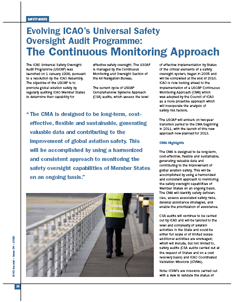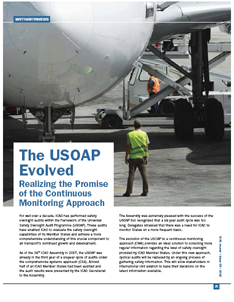ICAO's Universal Safety Oversight Audit Programme (USOAP) was launched initially in January 1999 in response to widespread concerns about the adequacy of aviation safety oversight around the world. Initially, USOAP activities consisted in regular and mandatory audits of ICAO Member States' safety oversight systems.
The programme was expanded in 2005 to the USOAP Comprehensive Systems Approach (CSA) to include safety-related provisions contained in all safety-related Annexes to the Chicago Convention. The USOAP CSA cycle which ended in December 2010 entailed about 40 safety oversight audits annually, with each ICAO Member State required to host an audit at least once during the cycle.
In September 2007, the 36th Session of the Assembly adopted Resolution A36-4 directing the Council to examine different options for the continuation of the USOAP beyond 2010, including the feasibility of applying a new approach based on the concept of continuous monitoring and incorporating the analysis of safety risk factors. The systematic and more proactive conduct of monitoring activities in the new USOAP Continuous Monitoring Approach (CMA) would make a more effective and efficient use of ICAO resources and reduce the burden on States caused by repetitive audits.
 |  |
In 2010, the 37th Session of the Assembly adopted Resolution A37-5, affirming that the evolution of USOAP to the CMA should continue to be a top priority for ICAO to ensure that information on the safety performance of Member States is provided to other Member States and to the travelling public on an ongoing basis. This vital improvement to international aviation safety required the participation and support of all Member States, particularly during the two-year transition period (2011 - 2012) while the tools and guidance required for USOAP CMA were developed.
As of January 2013, USOAP CMA is fully launched and its processes and tools are constantly reviewed to enable a more information-driven, risk-based and result-oriented approach. The objectives of the CMA include: monitoring States' safety oversight systems using a web-based platform — the "Online Framework" (OLF); validating States' progress through various on-site and off-site validation activities; and continuing to assess the effectiveness and sustainability of States' safety oversight systems through audits. With the CMA, the USOAP has gained in cost-effectiveness, dynamicity and flexibility (with the introduction of activities of limited scope).